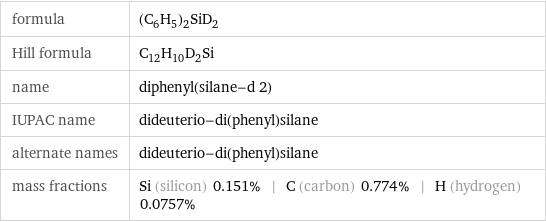Input interpretation

diphenyl(silane-d 2)
Chemical names and formulas

formula | (C_6H_5)_2SiD_2 Hill formula | C_12H_10D_2Si name | diphenyl(silane-d 2) IUPAC name | dideuterio-di(phenyl)silane alternate names | dideuterio-di(phenyl)silane mass fractions | Si (silicon) 0.151% | C (carbon) 0.774% | H (hydrogen) 0.0757%
Lewis structure

Draw the Lewis structure of diphenyl(silane-d 2). Start by drawing the overall structure of the molecule, ignoring potential double and triple bonds: Count the total valence electrons of the carbon (n_C, val = 4), hydrogen (n_H, val = 1), and silicon (n_Si, val = 4) atoms: 12 n_C, val + 12 n_H, val + n_Si, val = 64 Calculate the number of electrons needed to completely fill the valence shells for carbon (n_C, full = 8), hydrogen (n_H, full = 2), and silicon (n_Si, full = 8): 12 n_C, full + 12 n_H, full + n_Si, full = 128 Subtracting these two numbers shows that 128 - 64 = 64 bonding electrons are needed. Each bond has two electrons, so in addition to the 26 bonds already present in the diagram add 6 bonds. To minimize formal charge carbon wants 4 bonds. Identify the atoms that want additional bonds and the number of electrons remaining on each atom: Fill in the 6 bonds by pairing electrons between adjacent highlighted atoms. Note that the six atom rings are aromatic, so that the single and double bonds may be rearranged: Answer: | |
3D structure

3D structure
Basic properties

molar mass | 186.33 g/mol phase | liquid (at STP) boiling point | 96 °C (measured at 1733 Pa) density | 1.004 g/cm^3
Units

Liquid properties (at STP)

density | 1.004 g/cm^3 refractive index | 1.579
Units

Non-standard atom properties

H-2 | 2
Chemical identifiers
![CAS number | 17950-94-6 PubChem CID number | 12399551 PubChem SID number | 24871694 SMILES identifier | C1=CC=C(C=C1)[SiH2]C2=CC=CC=C2 InChI identifier | InChI=1/C12H12Si/c1-3-7-11(8-4-1)13-12-9-5-2-6-10-12/h1-10H, 13H2/i13D2 MDL number | MFCD01321367](../image_source/84af7af9c113055a9a14bc4f36dedd09.png)
CAS number | 17950-94-6 PubChem CID number | 12399551 PubChem SID number | 24871694 SMILES identifier | C1=CC=C(C=C1)[SiH2]C2=CC=CC=C2 InChI identifier | InChI=1/C12H12Si/c1-3-7-11(8-4-1)13-12-9-5-2-6-10-12/h1-10H, 13H2/i13D2 MDL number | MFCD01321367
Safety properties

flash point | 98.33 °C